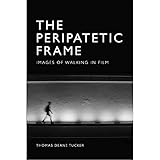The Peripatetic Frame : Images of Walking in Film / Thomas Deane Tucker.
Material type: TextPublisher: Edinburgh : Edinburgh University Press, [2022]Copyright date: ©2019Description: 1 online resource (168 p.) : 10 B/W illustrationsContent type:
TextPublisher: Edinburgh : Edinburgh University Press, [2022]Copyright date: ©2019Description: 1 online resource (168 p.) : 10 B/W illustrationsContent type: - 9781474409292
- 9781474409308
- 791.43/65 23
- online - DeGruyter
| Item type | Current library | Call number | URL | Status | Notes | Barcode | |
|---|---|---|---|---|---|---|---|
 eBook
eBook
|
Biblioteca "Angelicum" Pont. Univ. S.Tommaso d'Aquino Nuvola online | online - DeGruyter (Browse shelf(Opens below)) | Online access | Not for loan (Accesso limitato) | Accesso per gli utenti autorizzati / Access for authorized users | (dgr)9781474409308 |
Frontmatter -- Contents -- List of Figures -- Acknowledgements -- Introduction: Framing Walking -- 1. First Steps -- 2. Tramping with Chaplin -- 3. The Pedestrian Camera -- 4. Gumshoes -- 5. Homing -- 6. Aimless Walks -- Conclusion: Running Out of Frames -- Bibliography -- Filmography -- Index
restricted access online access with authorization star
http://purl.org/coar/access_right/c_16ec
The first philosophical exploration of the act of walking as it is represented in filmBreaks new ground in motion studies as it relates to film Helps readers gain a fresh insight into film history through another perspective Covers star walks, walking in genre films, urban walking, walking in nature and the idea of the camera as a pedestrianFrom cinema’s earliest days, walking and filmmaking have been intrinsically linked. Technologically, culturally and aesthetically, the pioneers of cinema were not only interested in using the camera to scientifically study ambulatory motion, but were also keen to capture the speed and mobile culture of late 19th-century urban life. Photographers such as Felix Nadar took their cameras into the Parisian streets and boulevards as mechanised flâneurs, ushering us into the age of the ‘mobilised virtual gaze’. But if photography could only embalm modernity in an instant of time, the cinema brought these instants to life again. From Muybridge and Marey’s photographic studies of motion to Charlie Chaplin’s character ‘The Tramp’, and from the Steadicam to the police procedural, Thomas Deane Tucker explores the intertwined relationship between cinema and walking from its very first steps – breaking new ground in motion studies and providing a bold new perspective on film history.
Mode of access: Internet via World Wide Web.
In English.
Description based on online resource; title from PDF title page (publisher's Web site, viewed 29. Jun 2022)


